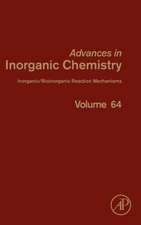Crystal Structure Determination
Autor Werner Massa Traducere de Robert O. Goulden Limba Engleză Paperback – 6 dec 2010
| Toate formatele și edițiile | Preț | Express |
|---|---|---|
| Paperback (1) | 450.33 lei 43-57 zile | |
| Springer Berlin, Heidelberg – 6 dec 2010 | 450.33 lei 43-57 zile | |
| Hardback (1) | 586.05 lei 43-57 zile | |
| Springer Berlin, Heidelberg – 18 feb 2004 | 586.05 lei 43-57 zile |
Preț: 450.33 lei
Nou
Puncte Express: 675
Preț estimativ în valută:
86.20€ • 93.66$ • 72.45£
86.20€ • 93.66$ • 72.45£
Carte tipărită la comandă
Livrare economică 21 aprilie-05 mai
Preluare comenzi: 021 569.72.76
Specificații
ISBN-13: 9783642058417
ISBN-10: 3642058418
Pagini: 224
Ilustrații: XI, 212 p.
Dimensiuni: 155 x 235 x 12 mm
Greutate: 0.32 kg
Ediția:Softcover reprint of hardcover 2nd ed. 2004
Editura: Springer Berlin, Heidelberg
Colecția Springer
Locul publicării:Berlin, Heidelberg, Germany
ISBN-10: 3642058418
Pagini: 224
Ilustrații: XI, 212 p.
Dimensiuni: 155 x 235 x 12 mm
Greutate: 0.32 kg
Ediția:Softcover reprint of hardcover 2nd ed. 2004
Editura: Springer Berlin, Heidelberg
Colecția Springer
Locul publicării:Berlin, Heidelberg, Germany
Public țintă
GraduateCuprins
1 Introduction.- 2 Crystal Lattices.- 3 The Geometry of X-Ray Diffraction.- 4 The Reciprocal Lattice.- 5 Structure Factors.- 6 Crystal Symmetry.- 7 Experimental Methods.- 8 Structure Solution.- 9 Structure Refinement.- 10 Additional Topics.- 11 Errors and Pitfalls.- 12 Interpretation and Presentation of Results.- 13 Crystallographic Databases.- 14 Outline of a Crystal Structure Determination.- 15 Worked Example of a Structure Determination.
Recenzii
From the reviews:
"Distinguished by its attention to the practicalities of working with real crystals…a lucid and relatively concise account of modern crystal structure solution …valuable to anyone who has an interest in crystal structure refinement." The Geological Journal
"The book provides a nice balance between describing the mathematical fundamentals and offering practical advice on how to solve a crystal structure… appropriate for an undergraduate audience (particularly in chemistry) and for graduate students or researchers who find they need a better grasp of the subject… a very helpful addition to the collection of introductory texts in X-ray crystallography. Especially for its treatment of common errors in the collection of intensity data and in the interpretation of results."
Acta Crystallographica
"Details at great length the inherent pitfalls and errors that one may encounter when calculating crystal structures using new software programs. The author does an excellent job of describing these errors and ways to recognize them when they appear in your calculations." Mineralium Deposita
From the reviews of the second edition:
"This textbook gives a concise introduction to modern crystal structure determination … . The theoretical sections are supported by many illustrations, and lay emphasis on a good understanding … . The most important data collection techniques … are discussed from a practical point of view. Many tips and insights help readers to recognise and avoid possible errors and traps, and to judge the quality of results." (Chimie Nouvelle Societe Royale de Chimie, Vol. 23 (89), juin, 2005)
“‘Crystal Structure Determination’ gives a concise introduction to the subject, with particular emphasis placed on the manner in which contemporary analysis actually occurs. … The strengths of this book are numerous. The presentation is excellent: the diagrams are plentiful and oftenimpressive, and the formatting of the text is very pleasing to the eye. … the research chemist with a desire to appreciate more fully a technique that they are likely to use with increasing frequency – the book should be a helpful companion.” (Andrew Bond, Crystallography News, June, 2004)
"Distinguished by its attention to the practicalities of working with real crystals…a lucid and relatively concise account of modern crystal structure solution …valuable to anyone who has an interest in crystal structure refinement." The Geological Journal
"The book provides a nice balance between describing the mathematical fundamentals and offering practical advice on how to solve a crystal structure… appropriate for an undergraduate audience (particularly in chemistry) and for graduate students or researchers who find they need a better grasp of the subject… a very helpful addition to the collection of introductory texts in X-ray crystallography. Especially for its treatment of common errors in the collection of intensity data and in the interpretation of results."
Acta Crystallographica
"Details at great length the inherent pitfalls and errors that one may encounter when calculating crystal structures using new software programs. The author does an excellent job of describing these errors and ways to recognize them when they appear in your calculations." Mineralium Deposita
From the reviews of the second edition:
"This textbook gives a concise introduction to modern crystal structure determination … . The theoretical sections are supported by many illustrations, and lay emphasis on a good understanding … . The most important data collection techniques … are discussed from a practical point of view. Many tips and insights help readers to recognise and avoid possible errors and traps, and to judge the quality of results." (Chimie Nouvelle Societe Royale de Chimie, Vol. 23 (89), juin, 2005)
“‘Crystal Structure Determination’ gives a concise introduction to the subject, with particular emphasis placed on the manner in which contemporary analysis actually occurs. … The strengths of this book are numerous. The presentation is excellent: the diagrams are plentiful and oftenimpressive, and the formatting of the text is very pleasing to the eye. … the research chemist with a desire to appreciate more fully a technique that they are likely to use with increasing frequency – the book should be a helpful companion.” (Andrew Bond, Crystallography News, June, 2004)
Caracteristici
Gives a concise introduction -- emphasising both the crystallographic background and how to actually perform it. Provides good understanding, supported by many illustrations, rather than rigorously deriving the mathematics. Discusses the most important measuring techniques, including the use of modern area detectors, and the methods of data reduction, structure solution and refinement from a practical point of view. Includes supplementary material: sn.pub/extras









